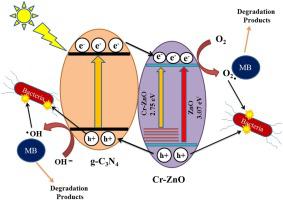Journal of Photochemistry and Photobiology A: Chemistry ( IF 4.1 ) Pub Date : 2020-07-13 , DOI: 10.1016/j.jphotochem.2020.112776 Muhammad Azam Qamar , Sammia Shahid , Mohsin Javed , Shahid Iqbal , Mudassar Sher , Muhammad Bilal Akbar

|
Currently, fabricating a narrow bandgap photocatalyst that can degrade pollutants in natural sunlight is critical but inspiring. In this study, a hybrid g-C3N4/Cr-ZnO nanocomposite was synthesized by a simple chemical co-precipitation method and its photocatalytic and antimicrobial properties were explored. In the first step, the photocatalytic efficiency of Cr-ZnO (1−9 wt. %) nanoparticles were carried out to find out the optimum doping of Cr into ZnO. The as-prepared 5% Cr-ZnO nanoparticles demonstrated the best optical absorption of sunlight and methylene blue degradation and in the second step; these were dispersed on g-C3N4 nanosheets as an active component to form ternary heterostructured photocatalyst. The nanoparticles and composite photocatalysts were characterized by X-ray diffraction spectroscopy, energy-disperse X-ray spectroscopy, transmission electron microscopy, Fourier transform infrared spectroscopy and ultraviolet-visible spectroscopy. The optimized composite (60 %g-C3N4/5%Cr-ZnO) performed enhanced harvesting of solar energy compared to ZnO, g-C3N4 and g-C3N4/ZnO composite, achieving 93 % methylene blue dye degradation in 90 min. The improved photocatalytic activity of composite can be attributed to the better absorption and electron-hole pair separation between g-C3N4 and Cr-ZnO. The photocatalytic stability of the composite was testified by cyclic tests. The antibacterial aptitude of the samples was investigated against Gram-negative (Escherichia coli) and Gram-positive (Bacillus subtilis, Staphylococcus aureus and Streptococcus salivarius) bacteria applying diffusion well method. The 60 %g-C3N4/5%Cr-ZnO nanocomposite exhibits higher antibacterial activity compared to other samples. The enriched photocatalytic and antimicrobial activities of the composite may be predominantly ascribed to the synergistic effect of the heterojunction developed between g-C3N4 and Cr-ZnO.
中文翻译:

高效gC 3 N 4 / Cr-ZnO纳米复合材料,具有优异的光催化和抗菌活性
当前,制造能在自然阳光下降解污染物的窄带隙光催化剂是至关重要的,但却具有启发性。本研究通过简单的化学共沉淀法合成了杂化的gC 3 N 4 / Cr-ZnO纳米复合材料,并探讨了其光催化和抗菌性能。第一步,对Cr-ZnO(1-9 wt。%)纳米粒子进行光催化效率,以找出Cr最佳掺杂到ZnO中的方式。所制备的5%Cr-ZnO纳米颗粒在第二步中表现出最佳的太阳光吸收光和亚甲基蓝降解。这些分散在gC 3 N 4上纳米片作为活性成分形成三元异质结构光催化剂。通过X射线衍射光谱,能量分散X射线光谱,透射电子显微镜,傅立叶变换红外光谱和紫外可见光谱对纳米颗粒和复合光催化剂进行了表征。与ZnO,gC 3 N 4和gC 3 N 4 / ZnO复合材料相比,优化的复合材料(60%gC 3 N 4 /5%Cr-ZnO)增强了太阳能的收集,在90分钟内实现了93%的亚甲基蓝染料降解。复合材料提高的光催化活性可以归因于gC 3之间更好的吸收和电子-空穴对分离N 4和Cr-ZnO。通过循环测试证明了复合材料的光催化稳定性。采用扩散孔法研究了样品对革兰氏阴性菌(大肠杆菌)和革兰氏阳性菌(枯草芽孢杆菌,金黄色葡萄球菌和唾液链球菌)的抗菌能力。与其他样品相比,60%gC 3 N 4 /5%Cr-ZnO纳米复合材料表现出更高的抗菌活性。复合材料丰富的光催化和抗菌活性可能主要归因于gC 3 N 4和Cr-ZnO之间形成的异质结的协同效应。











































 京公网安备 11010802027423号
京公网安备 11010802027423号